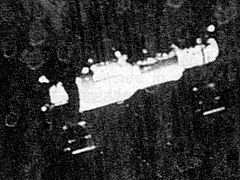
Back Saljoet 1 Afrikaans ساليوت 1 Arabic Salyut 1 Azerbaijani Салют-1 Bulgarian Saliut 1 Catalan Saljut 1 Czech Salyut 1 Welsh Saljut 1 German Salut 1 Esperanto Saliut 1 Spanish
 Salyut 1 as seen from the departing Soyuz 11 | |
 | |
| Station statistics | |
|---|---|
| COSPAR ID | 1971-032A |
| SATCAT no. | 05160 |
| Call sign | Salyut 1 |
| Crew | 3 |
| Launch | April 19, 1971, 01:40:00 UTC[1] |
| Carrier rocket | Proton-K |
| Launch pad | Site 81/24, Baikonur Cosmodrome, Soviet Union |
| Reentry | October 11, 1971 |
| Mission status | De-orbited |
| Mass | 18,425 kg (40,620 lb) |
| Length | ~20 m (66 ft) |
| Diameter | ~4 m (13 ft) |
| Pressurized volume | 99 m3 (3,500 cu ft) |
| Perigee altitude | 200 km (124 mi) |
| Apogee altitude | 222 km (138 mi) |
| Orbital inclination | 51.6 degrees |
| Orbital period | 88.5 minutes |
| Days in orbit | 175 days |
| Days occupied | 24 days |
| No. of orbits | 2,929 |
| Distance traveled | 118,602,524 km (73,696,192 mi) |
| Configuration | |
 Soyuz docking with Salyut 1 | |
Salyut 1 (DOS-1) (Russian: Салют-1) was the world's first space station launched into low Earth orbit by the Soviet Union on April 19, 1971. The Salyut program followed this with five more successful launches of seven more stations. The final module of the program, Zvezda (DOS-8), became the core of the Russian segment of the International Space Station and remains in orbit.
Salyut 1 was modified from one of the Almaz airframes, and was made out of five components: a transfer compartment, a main compartment, two auxiliary compartments, and the Orion 1 Space Observatory.
Salyut 1 was visited by Soyuz 10 and Soyuz 11. The hard-docking of Soyuz 10 failed and the crew had to abort this mission. The Soyuz 11 crew achieved successful hard docking and performed experiments in Salyut 1 for 23 days. However, they were killed by asphyxia caused by failure of a valve just prior to Earth reentry, and are the only people to have died above the Kármán line. Salyut 1's mission was later terminated, and it burned up on reentry into Earth's atmosphere on October 11, 1971.
© MMXXIII Rich X Search. We shall prevail. All rights reserved. Rich X Search